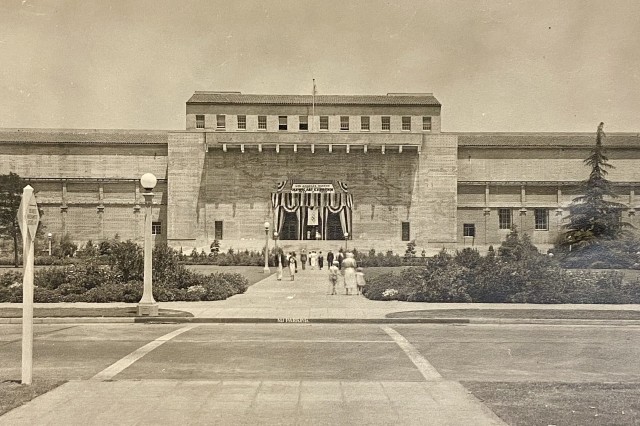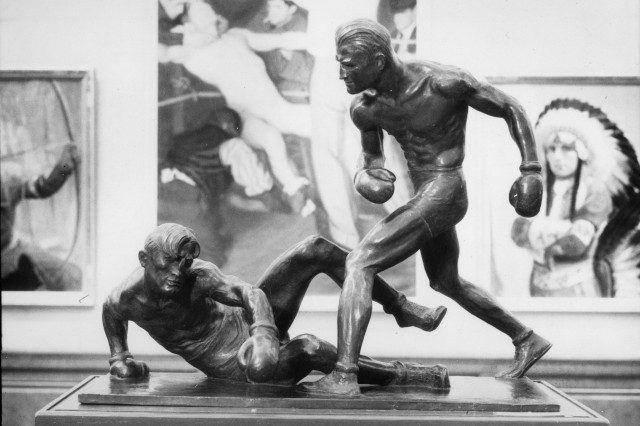Out of an abundance of caution for the safety of our visitors and staff, the museum will be closing at 3 pm on December 24 due to the impending storms. The museum will be closed Thursday, December 25 for the Christmas holiday. We will reopen Friday, December 26.
The Olympics in Los Angeles: Back to the Future
Los Angeles first hosted the 1932 Summer Games for the Xth Olympiad. The Museum, then called the Los Angeles County Museum of History, Science and Art, provided the venue for the Olympic Art Exhibition.

Recently the city marked the 40th anniversary of the 1984 Summer Olympics, officially known as the Games of the XXIII Olympiad, held in Los Angeles from July 28 to August 12, and the Museum served as a host hospitality center.
As in 1932, a concurrent Olympics Arts Festival took place, and the History Department produced a three-prong exhibition covering a revisit of the 1932 Games, the Great Depression, and the cars of 1932.

Senior Collections Manager, John Cahoon, was an integral member of the Arts Festival, and he also served as an Olympics volunteer! Here is a Q&A with John about his participation in 1984:
Could you tell us about your blue uniform?
The 1984 Los Angeles County Host Committee wanted the volunteers to stand out from the crowd so that visitors who had questions or wanted assistance could easily spot them. I was issued the jacket, pants, a tie, two dress shirts and the shoes. Unusual pastel colors were selected for various uniforms. Even more noticeable than this off-shade of blue were the bright orange coats worn by another group of volunteers.
What inspired you to volunteer at LAX while everyone was fearing a carmageddon?
Those who volunteered at events during the Games often found themselves outside the competition arena, didn't get to see the competition and could only hear the crowds. I wanted to be able to watch the events so I volunteered at LAX the two weeks before the Games started when teams were arriving. We'd meet them, direct them to accreditation, and then get them onto the buses that took them to the various Olympic housing locations.
Traffic was actually less congested during the 1984 Games because of the Organizing Committee's excellent busing system that brought spectators in from the suburbs reducing the number of cars on the roads. And they arranged with businesses to have trucks make deliveries early in the morning before rush hours which further reduced traffic.
Were there any memorable visitors whom you assisted as a volunteer?
One evening I was stationed at the International Terminal, and a well-dressed woman in dark glasses and a scarf over her head inquired about an incoming flight from Rome, as she was waiting for arriving passengers. I informed the lady that the plane was now on the ground but that it was taking a little longer to go through customs when I realized I was speaking to actress Audrey Hepburn.
I also saw singer Kenny Rogers at the Opening Ceremonies and actress Shelley Winters at one of the track & field competitions in the Coliseum.
What are you looking forward to at LA28?
I'd like to see the competitions, of course—but I'd also like to be a volunteer again. It was a great experience last time.


Courtesy of the Seaver Center for Western History Research
Exterior view of LA County Museum of History, Science and Art south entrance and shows the banner hanging for Olympics fine arts exhibit and competition, 1932, taken by Henry Wylde who later became Chief of Museum Exhibits

Courtesy of Seaver Center for Western History
View of the gallery where more than 1,100 works were exhibited by artists from 31 countries

Courtesy of the Seaver Center for Western History Research
Another gallery view shows paintings representing France

Courtesy of the Seaver Center for Western History Research
Members of the international painting jury - Reginald Poland, John Johansen, Eugene Savage and David Alfaro Siqueiros.

Courtesy of the Seaver Center for Western History Research
"The Knockdown" by Mahonri Young won first place in the sculpture competition
1 of 1
Exterior view of LA County Museum of History, Science and Art south entrance and shows the banner hanging for Olympics fine arts exhibit and competition, 1932, taken by Henry Wylde who later became Chief of Museum Exhibits
Courtesy of the Seaver Center for Western History Research
View of the gallery where more than 1,100 works were exhibited by artists from 31 countries
Courtesy of Seaver Center for Western History
Another gallery view shows paintings representing France
Courtesy of the Seaver Center for Western History Research
Members of the international painting jury - Reginald Poland, John Johansen, Eugene Savage and David Alfaro Siqueiros.
Courtesy of the Seaver Center for Western History Research
"The Knockdown" by Mahonri Young won first place in the sculpture competition
Courtesy of the Seaver Center for Western History Research
